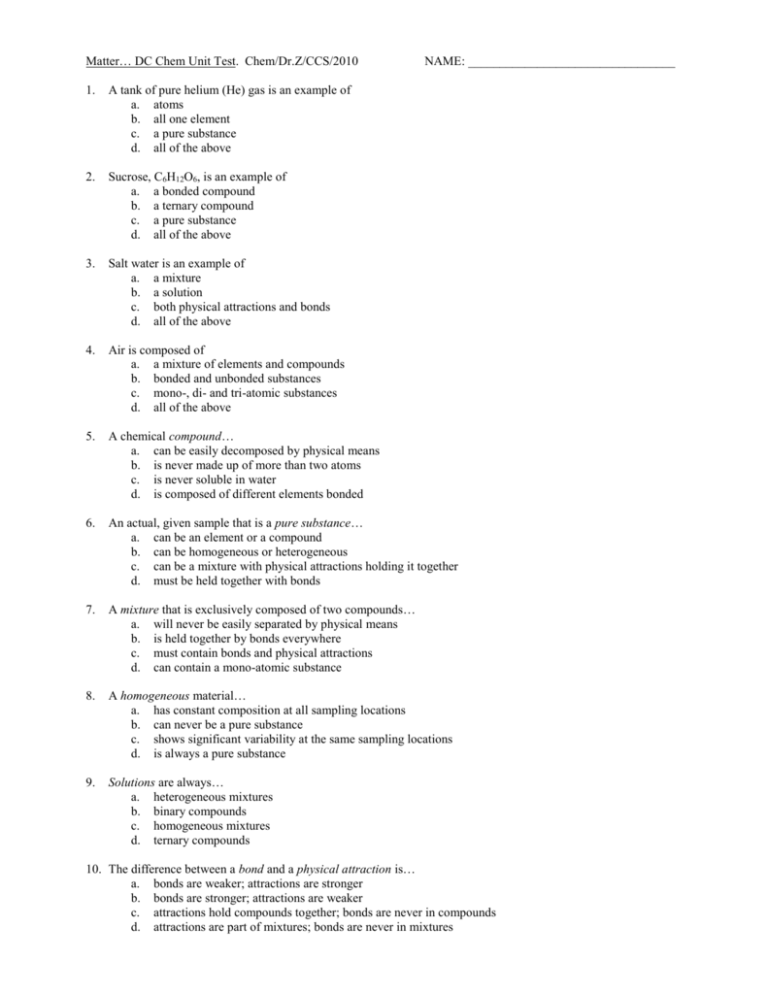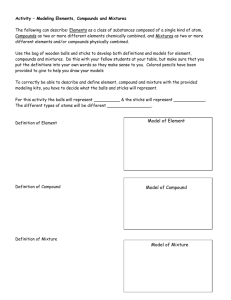1MattCharUT2010
advertisement

Matter… DC Chem Unit Test. Chem/Dr.Z/CCS/2010 NAME: _________________________________ 1. A tank of pure helium (He) gas is an example of a. atoms b. all one element c. a pure substance d. all of the above 2. Sucrose, C6H12O6, is an example of a. a bonded compound b. a ternary compound c. a pure substance d. all of the above 3. Salt water is an example of a. a mixture b. a solution c. both physical attractions and bonds d. all of the above 4. Air is composed of a. a mixture of elements and compounds b. bonded and unbonded substances c. mono-, di- and tri-atomic substances d. all of the above 5. A chemical compound… a. can be easily decomposed by physical means b. is never made up of more than two atoms c. is never soluble in water d. is composed of different elements bonded 6. An actual, given sample that is a pure substance… a. can be an element or a compound b. can be homogeneous or heterogeneous c. can be a mixture with physical attractions holding it together d. must be held together with bonds 7. A mixture that is exclusively composed of two compounds… a. will never be easily separated by physical means b. is held together by bonds everywhere c. must contain bonds and physical attractions d. can contain a mono-atomic substance 8. A homogeneous material… a. has constant composition at all sampling locations b. can never be a pure substance c. shows significant variability at the same sampling locations d. is always a pure substance 9. Solutions are always… a. heterogeneous mixtures b. binary compounds c. homogeneous mixtures d. ternary compounds 10. The difference between a bond and a physical attraction is… a. bonds are weaker; attractions are stronger b. bonds are stronger; attractions are weaker c. attractions hold compounds together; bonds are never in compounds d. attractions are part of mixtures; bonds are never in mixtures 11. Distilled water is an example of… a. a mixture b. a compound c. an element d. an atom 12. Using ’s and ’s, draw a mixture in a beaker, composed of an element and a compound. Use a solid line or closeness to depict a bond; and a dotted line or distance to show an attraction. 13. Raising the temperature of 7.0 mL of water from 274 K to 284 K requires approximately how much heat? a. 4.18 J b. 290 J c. 400 J d. 334 J 14. NaCl(aq)+ AgNO3(aq) (new compounds), and the temperature surrounding the reaction increases. The process is: a. entirely physical b. exothermic c. endothermic d. entirely chemical 15. When a 30.0 gram sample of solid water at 273 K is completely melted, how much heat must be absorbed? You must show the equation, substitutions and answer, with all units, for full credit. 16. A 54 g sample of Candorium is cooled from 30 to 20 degrees Celsius, releasing 270 J of heat. What is the specific heat capacity for the substance Candorium? Please show equation, substitutions and all units, for full credit. 17. Is an explosion an exothermic or endothermic chemical reaction? Using the heating curve below… 18. For segment bc identify phase(s)… Answer: ________________________ 19. For swegment ef identify the dominant process… Answer: ____________________________ 20. Identify a segment where there is no significant change in potential energy. _____________ 21. What is the approximate freezing point temperature of this substance? Answer: _____________ 22. What’s happening to KE during segment de? Answer: _____________________________________ Temperature (°C) 23. Which mode(s) of motion would be expected on segment de? Answer: __________________________________ +50 +40 f +30 d e +20 b c 0 a -10 Heat Added 24. When a sample of liquid water of unknown mass at 100 C absorbs 11,300 J of heat to undergo complete phase change, what does this indicate the mass of liquid must have been? Please show the equation, substitutions and answer, with all units, for full credit. 25. Raising the temperature of 7.0 mL of water from 274 K to 284 K requires approximately how much heat? Equations; substitutions; all units—please.








